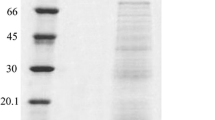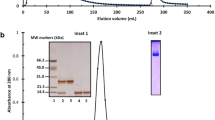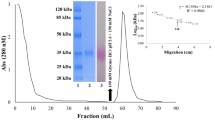Abstract
The cDNA for pre-pro-Concanavalin A (pre-pro-ConA) was cloned into the cytoplasmic expression vector pKK233-2 to give rise to pCONEXP2 which was used to express the lectin precursor. Pre-pro-ConA is stable and is not transposed and ligated to form the mature protein. No signal peptide removal is observed. The solubility of pre-pro-ConA could not be increased by guanidine hydrochloride denaturation/dilution treatment.
Similar content being viewed by others
Abbreviations
- ConA:
-
Concanavalin A
- IPTG:
-
isopropyl-Β-D-thiogalactopyranoside
- PMSF:
-
phenyl methyl sulphonyl flouride
References
Amann E and Brosius J 1985 ‘ATG’ vectors for regulated expression of cloned genes inEscherichia coli;Gene 40 183–190
Bowles D J, Marcus S E, Pappin D J C, Findlay J B C, Eliopoulos E, Maycox P R and Burgess J 1986 Post-translational processing of ConA precursors in Jack Bean cotyledons;J. Cell Biol. 102 1284–1297
Carrington D M, Aufret A and Hanke D E 1985 Polypeptide ligation occurs during post-translational processing of Concanavalin A;Nature (London) 313 64–67
Cunningham B A, Wang J L, Waxdal M J and Edelman G M 1975 The covalent and the three dimensional structure of Concanavalin A;J. Biol. Chem. 250 1503–1512
Gatenby A A, Boccara M, Baulcombe D C and Rothstein S J 1986 Expression of wheat α-amylase inEscherichia coli;Gene 45 11–18
Goldstein I J and Poretz R D 1986 Isolation and characterization and carbohydrate specificity of lectins; inThe lectins: Properties, functions and applications in biology and medicine (eds) I E Liener, N Sharon and I J Goldstein (London: Academic Press) pp
Harlow E and Lane D 1989Antibodies: A laboratory manual (New York: Cold Spring Laboratory)
Hemperly J J and Cunningham B A 1985 Circular permutation of amino acid sequences among legume lectins;Trends Biochem. Sci. 8 100–102
Herman E M, Shannon L M and Chrispeels M J 1986 Concanavalin A is synthesized as a glycosylated precursor;Planta 165 23–29
Jones D H, Min W, Dincturk H B, Dunn A J, Williams R P and Li M 1996 Concanavalin A and precursors used to investigate its extraordinary post-translational processing; inLectins: Biology, biochemistry, clinical biochemistry (eds) E Van Driessche, P Rouge, S Beeckmans and T C Bog-Hansen (Denmark: Textop) vol. 11, pp 70–73
Kozak M 1983 Comparison and initiation of protein synthesis in prokaryotes, eukaryotes and organelles;Microbiol. Rev. 47 1–45
Min W, Dunn A J and Jones D H 1992 Non-glycosylated recombinant pro-Concanavalin A is active without polypeptide cleavage;EMBO J. 11 1303–1307
Min W and Jones D H 1992 Stability and detection of recombinant pre-pro-Concanavalin A after cytoplasmic expression inEscherichia coli;FEBS Lett. 301 315–318
Min W and Jones D H 1994In vitro splicing of Concanavalin A is catalysed by asparaginyl endopeptidase;Nature Struct. Biol. 1 502–504
Mitraki A and King J 1990 Protein folding intermediates and inclusion body formation;Bio/Technology 7 690–697
Sambrook J, Fritsch E F and Maniatis T 1989Molecular cloning, Second edition (New York: Cold Spring Harbour Laboratory)
Stubbs M E, Carver J P and Dunn R J 1986 Production of pea lectin inEscherichia coli;J. Biol. Chem. 261 6141–6144
Williams T J, Shafer J A and Goldstein I J 1978 Heterogeneity of Concanavalin A as detected by its binding to p-nitrophenyl 2-0-α-D-mannopyronoside;J. Biol. Chem. 253 8533–8537
Yamauchi D and Minimikawa T 1990 Structure of the gene coding for Concanavalin A fromCanavalia gladiata and its expression inEscherichia coli cells;FEBS Lett. 260 127–130
Yamauchi D, Nakamura K, Asahi T, Minimikawa T 1988 cDNAs for canavalin and Concanavalin A fromCanavalia gladiata seeds. Nucleotide sequence of cDNA and canavalin and RNA blot analysis of canavalin and Concanavalin A in developing seeds;Eur. J. Biochem. 170 515–520
Author information
Authors and Affiliations
Corresponding author
Rights and permissions
About this article
Cite this article
Dincturk, H.B., Dunn, A.J. & Jones, D.H. Recombinant pre-pro-Concanavalin A (jack bean) is stable but of low solubility. J. Biosci. 26, 635–640 (2001). https://doi.org/10.1007/BF02704761
Received:
Accepted:
Published:
Issue Date:
DOI: https://doi.org/10.1007/BF02704761




